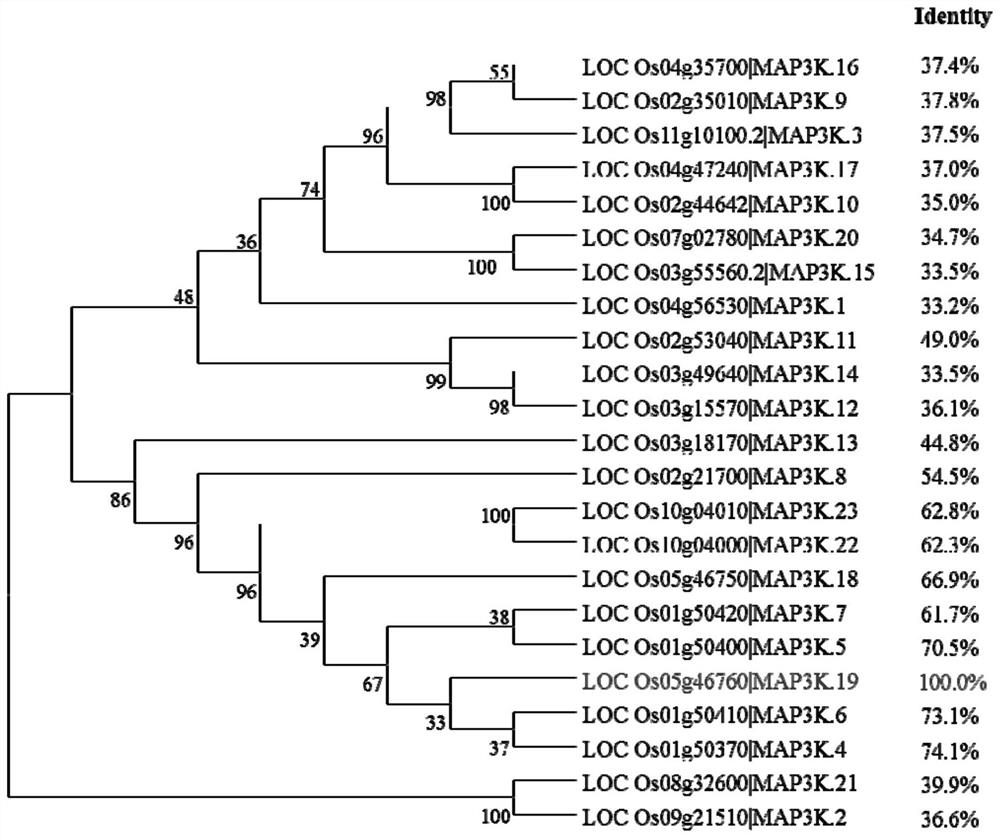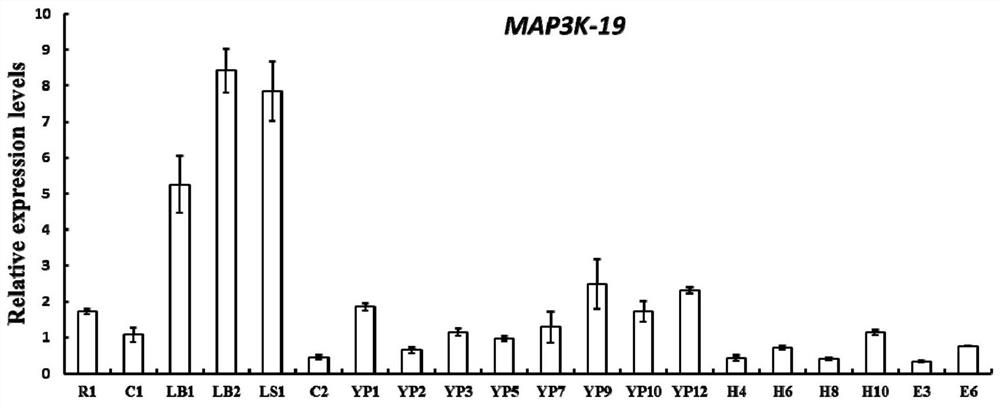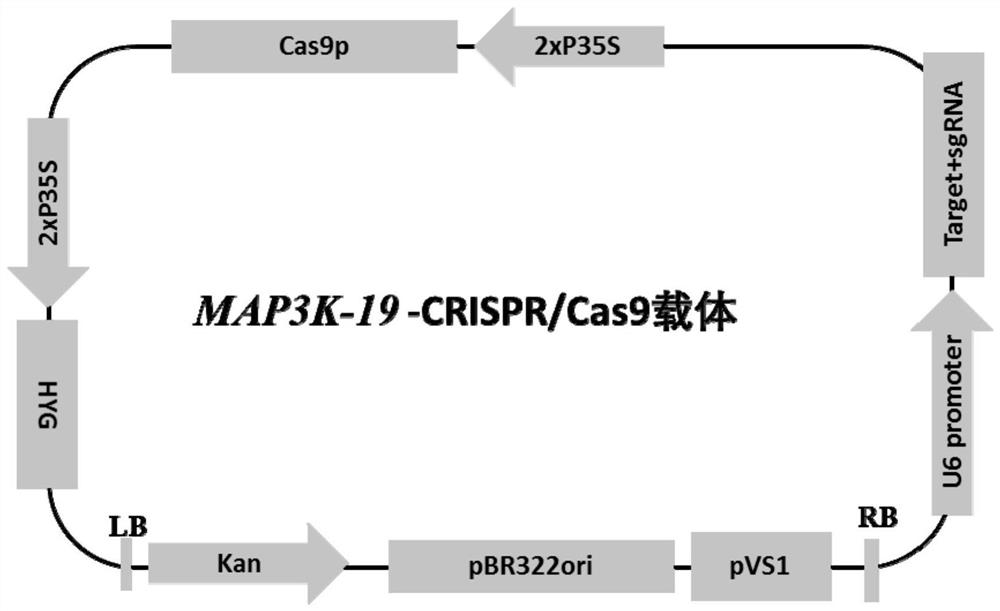A map3k-19 gene and its encoded protein for improving high temperature tolerance in rice heading stage and its application
A 1. MAP3K-19, high temperature tolerance technology, applied in the field of genetic engineering, can solve problems such as lack of MAPK pathway genes
- Summary
- Abstract
- Description
- Claims
- Application Information
AI Technical Summary
Problems solved by technology
Method used
Image
Examples
Embodiment 1
[0025] Example 1: Homology comparison analysis of MAP3K family protein sequences
[0026] 1. Homologous gene sequence acquisition
[0027] The protein sequence of rice is from the Rice Genome Annotation Project (http: / / rice.plantbiology.msu.edu). There are a total of 23 rice samples, and their ID numbers and names are as follows: LOC Os04g35700|MAP3K.16, LOC Os02g35010|MAP3K.9, LOC Os11g10100.2|MAP3K.3, LOC Os04g47240|MAP3K.17, LOC Os02g44642|MAP3K.10, LOC Os07g02780|MAP3K.20, LOC Os03g55560.2|MAP3K.15, LOC Os04g56530|MAP3K.1, LOC Os02g53040|MAP3K.11, LOC Os03g49640|MAP3K.14, LOC Os03g15570|MAP3K130|MAP3K.170, , LOC Os02g21700|MAP3K.8, LOC Os10g04010|MAP3K.23, LOC Os10g04000|MAP3K.22, LOC Os05g46750|MAP3K.18, LOC Os01g50420|MAP3K.7, LOC Os01g50600|MAP3K.5, 9g LOC Os01g50410|MAP3K.6, LOC Os01g50370|MAP3K.4, LOC Os08g32600|MAP3K.21, LOC Os09g21510|MAP3K.2.
[0028] 2. Creation of evolutionary tree
[0029] Use Clustal Omega (https: / / www.ebi.ac.uk / Tools / msa / clustalo / ) to alig...
Embodiment 2
[0035] Example 2: Construction of MAP3K-19 gene editing vector
[0036] 1. Gene editing site design
[0037] According to the existing CRISPR / Cas9 construction method in our laboratory, the GTGCGCGAGGTGGGCGGATTCGG sequence containing CGG as the recognition site was selected as the knockout target site of MAP3K-19 on the first exon of MAP3K-19 ( figure 2 ), hoping to obtain loss-of-function transgenic plants to clarify the function of MAP3K-19 gene.
[0038] 2. CRISPR / Cas9 vector construction
[0039] First, mix 5 μL of 10 μM primers before and after the target site, anneal at 99°C for 5 minutes to obtain the sequence containing the double-strand knockout site, and then use Bas1 (NEB Company) to ligate while digesting (37°C) to ligate the sequence of the target site. To the intermediate vector pYLsgRNA-OsU6a, and then use the universal amplification primers CTCCGTTTTACCTGTGGAATCG (UF) and CGGAGGAAAATTCCATCCAC (gR-R) in combination with the back primer and front primer of the...
Embodiment 3
[0046] Example 3: MAP3K-19 gene editing under the background of japonica rice Nipponbare
[0047] 1. Detection of transgenic seedlings
[0048] A total of 15 seedlings were obtained by Agrobacterium infection and transformation. First, the G418 detection primer was used to detect the transformation of the vector, and then the amplification primers U524 (GGACGTGGCCAGGGGGCTCG) + U525 (CATGTCGCTCCACGGC) across the target site were used to amplify the sequences in all the positive transformation plants. Sent to Qingke Sequencing Company for sequencing, the results are as follows Figure 4 As shown, the comparison analysis of the obtained sequences showed that a total of 1 knockout plant with premature termination of protein translation was obtained.
[0049] 2. Phenotype Survey
[0050] In the T1 generation planting, the transgenic lines were divided into 3 repeated plantings in field experiments, and 2 rows were planted for each repeated planting. First, the presence of stable ...
PUM
 Login to View More
Login to View More Abstract
Description
Claims
Application Information
 Login to View More
Login to View More - R&D
- Intellectual Property
- Life Sciences
- Materials
- Tech Scout
- Unparalleled Data Quality
- Higher Quality Content
- 60% Fewer Hallucinations
Browse by: Latest US Patents, China's latest patents, Technical Efficacy Thesaurus, Application Domain, Technology Topic, Popular Technical Reports.
© 2025 PatSnap. All rights reserved.Legal|Privacy policy|Modern Slavery Act Transparency Statement|Sitemap|About US| Contact US: help@patsnap.com



